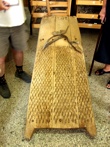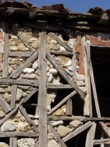|
|
| Ethnographic research |
 An ethnographic study is being conducted of the inhabitants of the area, with an aim to recording their experiences concerning matters of agricultural practice, particularly pre-industrial practice. A systematic record is being made of information and data related to the agricultural activities of the inhabitants, starting with the eldest, and other aspects of daily life, which will allow us to reconstruct the local history into the distant past. An ethnographic study is being conducted of the inhabitants of the area, with an aim to recording their experiences concerning matters of agricultural practice, particularly pre-industrial practice. A systematic record is being made of information and data related to the agricultural activities of the inhabitants, starting with the eldest, and other aspects of daily life, which will allow us to reconstruct the local history into the distant past. |
| |
| Cultivation practices |
Interwiews were conducted with local informants, usually in their old age, with a focus on a number of issues, such as eating habits and the cultivation uses of the land in the early 20th century. An element of recent land use at Paliambela is most probably of some importance for prehistoric production practices:
the small lots given to the refugees from Eastern Thrace when they settled in Paliambela obliged them to adopt more intensive forms of cultivation work in relation to the native inhabitants. This constitutes a good example of mechanisms which are motivated by wider social and economic conditions. We can hypothesise that similar answers were given by prehistoric agricultural and stock farmers. |
| |
| Changes in the landscape |
 The informants also describe how the landscape around Paliambela has changed significantly over the last few decades. The nearby slopes which used to be used for pasturing animals and the collection of firewood have been significantly deforested, while the streams that were available for irrigation and fishing are no longer suitable. Long-term environmental change will be the focus of the geoarchaeological study, since the initial survey shows that the relevant testimonies are preserved in the landscape. The informants also describe how the landscape around Paliambela has changed significantly over the last few decades. The nearby slopes which used to be used for pasturing animals and the collection of firewood have been significantly deforested, while the streams that were available for irrigation and fishing are no longer suitable. Long-term environmental change will be the focus of the geoarchaeological study, since the initial survey shows that the relevant testimonies are preserved in the landscape. |
| |
| The diachronic mapping of the area |
| The changes in the agricultural exploitation of the landscape up to the advent of mechanised cultivation is also the subject of study. Based on oral testimonies, but also on access obtained to Ottoman and more recent Greek records, there is a plan to map out the agricultural properties and the changes they have undergone. |
| |
| Traditional constructions |
 Interviews with old builders and the study of traditional buildings in the surrounding area, particularly in the neighbouring town of Kolindros, have given a fair amount of data on traditional construction techniques which seem to bear similarities with the architectural elements observed in the excavation of the Neolithic settlement. Many of the houses in Kolindros have foundations of large stones, on top of which smaller stones or even pebbles are compacted with clay and straw on wooden frames. Analogous examples are also appearing in the excavation, where masses of pebbles are associated both with paving stones and with possible collapsed walls. Interviews with old builders and the study of traditional buildings in the surrounding area, particularly in the neighbouring town of Kolindros, have given a fair amount of data on traditional construction techniques which seem to bear similarities with the architectural elements observed in the excavation of the Neolithic settlement. Many of the houses in Kolindros have foundations of large stones, on top of which smaller stones or even pebbles are compacted with clay and straw on wooden frames. Analogous examples are also appearing in the excavation, where masses of pebbles are associated both with paving stones and with possible collapsed walls. |
|
|





